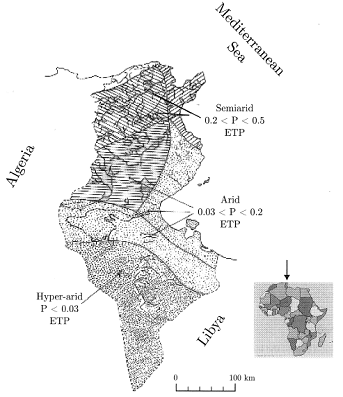Driving forces in the Mediterranean
According to the UNCCD and the countries themselves, the Mediterranean countries of Portugal, Spain, Italy, Greece and Turkey have a marked problem of desertification because of the occurrence of particular conditions over large areas (UN, 1994). These conditions include:
- semi-arid climatic conditions affecting large areas; seasonal droughts; high rainfall variability and sudden and high-intensity rainfall; poor and highly erodible soils prone to develop surface crusts;
- uneven relief with steep slopes and diversified landscapes;
- extensive forest losses due to frequent wild and anthropogenic fires;
- crisis conditions in traditional agriculture with associated land abandonment and deterioration of traditional soil and water conservation measures;
- unsustainable exploitation of water resources leading to serious environmental damage, including chemical pollution, salinization and exhaustion of aquifers; and
- concentration of economic activity in coastal areas as a result of urban growth, industrial activities, tourism and irrigated agriculture.
- Political decisions regarding e.g. subsidy on certain crops of infrastructure.
In northern Africa, the causes of land degradation can be grouped, according to Conacher and Sala (1998) into:
- loss of plant cover and increased erosion,
- lithology and pedology,
- rainfall concentration and intensity;
- demographic explosion and
- human factors and social aspects.
Two case studies from the Mediterranean, one in Sardinia and one in Tunisia, are described briefly to illustrate the causes of desertification in more detail in the area of interest of this literature review.
Example case study 1: Sardinia (Enne et al., 2002)
Sardinia is one of Italy's regions most threatened by land degradation, with unproductive lands representing about 12% of the total area (excluding urban and coastal areas and inland waters). About 85% of the Sardinian land is currently used for agriculture, with livestock farming being one of the main economic activities. This results in intensively grazed meadows and pastures and both wooded areas and arable land are cultivated to provide forage and other animal feeding sources.
In order to evaluate the effect of agro-pastoral activities on land degradation, a case study in Sardinia was carried out under the auspices of the MEDALUS II project. Animal behaviour was studied and the effects of stock trampling on soils were determined. From the latter is it was concluded that winter is the season during which the risk of soil degradation due to trampling is highest, as soil moisture values are highest then. The effect of continuous high stocking rates was compared to ungrazed areas (marginal areas with low productive potential due to steep slopes, stoniness and limited soil depth). The use of high and continuous stocking rates caused an increase in the area of bare soil surface, leading to increased soil erosion risk. Comparisons between a ploughed-cereal area and a natural Maquis area showed that the latter maintained soil losses far below the critical level in autumn. The intensification of cropping on hillslopes increased erosion risk, particularly if crop establishment was slow and ploughing was done across contours instead of parallel to them. The authors conclude that practices related to agro-pastoral activities, such as overgrazing, badly planned cultivation and the use of fire to clear pastures, can be considered the main causes of desertification.
Example case study 2: Tunisia (Mtimet et al., 2002)
Tunisia has extensive arid zones (see Fig. 3.3) that are extremely sensitive to various forms of land degradation and a number of development programmes and studies to combat desertification are executed in the country. Arid bioclimates cover over 63,000 km2, of which 11.8 % has been assessed to be very degraded, 36.6% to be moderately degraded and 17% to be slightly degraded (Mtimet et al., 2002). There has been no significant climatic changes since the end of the last century, so the authors state that the present signs of desertification cannot be attributed to an increasing dryness of the climate. Instead, they are caused by human and animal pressure on fragile ecosystems. The stresses are listed as follows:
- inappropriate use of soils, through extending arboriculture and cereal crops into zones that should be used as rangelands only;
- use of inappropriate equipment for the preparation of soils (e.g. the use of polydisc ploughs in sandy soils sensitive to wind erosion);
- increasing numbers of livestock in conjunction with a decrease in the area of rangeland, resulting in overgrazing, a deterioration of soils and a decrease in plant species suitable for grazing;
- removal of wood for domestic use, which is one of the main causes of the decline of tree and shrub species;
- use of high salinity water for irrigation, contributing to the salinization of soils and the decline of their fertility; and
- urbanization, particularly in coastal areas and around ancient cities and towns, resulting in land, often the most fertile areas, taken out of production.
These pressures work as causes of degradation, as their effects include water and wind erosion, deterioration of the vegetation cover, and degradation due to hydromorphy and salinization.

Fig. 3.3: Bioclimatic map of Tunisia (from: Mtimet et al., 2002)